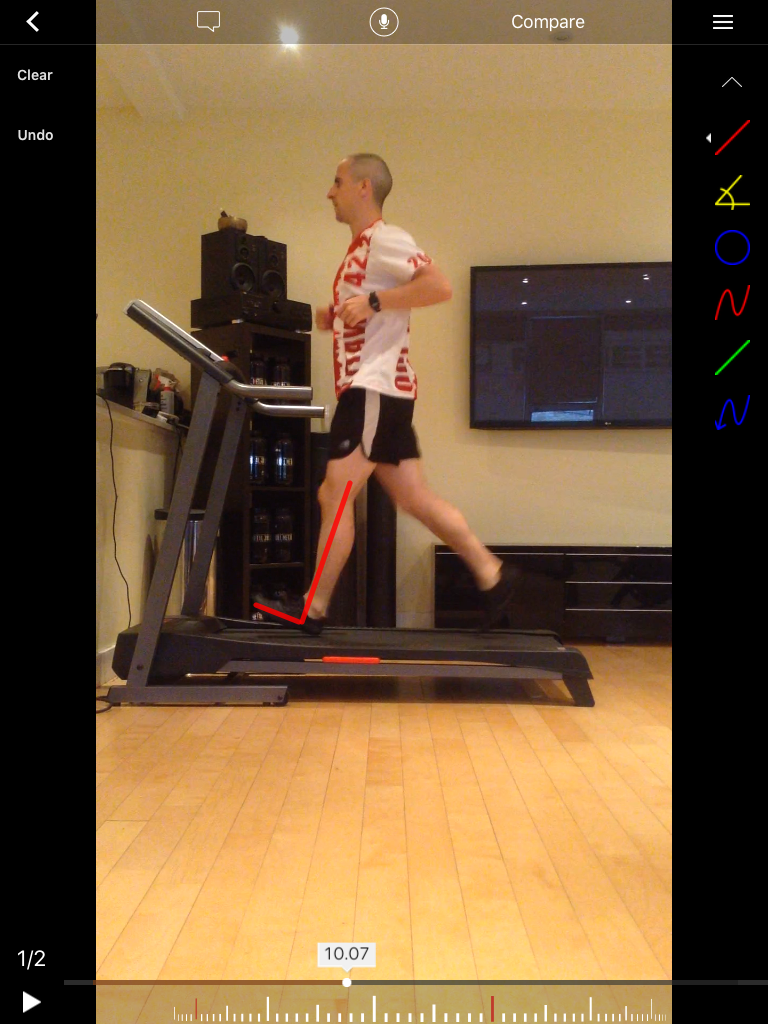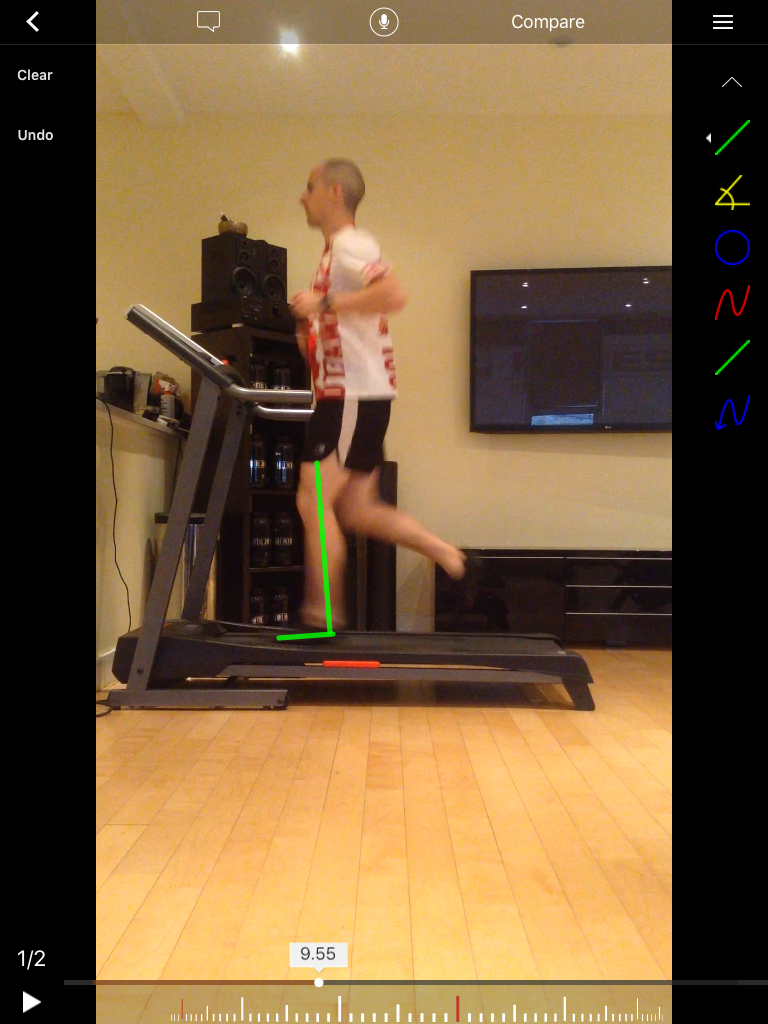Why should I care about my running cadence?
Well, optimizing your running cadence can help you avoid injuries and improve your performance.
Is that a good enough reason?
If so, read on.
What is Running Cadence?
Your running cadence is the number of strides you take each minute (spm). Basically if you were to count each time your foot hit the ground during one minute of running you would have your running cadence.
Good Running Cadence
Optimal running cadence is in the 170 to 190 spm range for most people. Check out the video below with me running on a treadmill with a cadence of 190:
Anyway, it means my form is pretty good on the whole. Don’t get me wrong, I’m just a recreational runner like you and my marathon times are nothing too impressive. I just happen to have an interest in running technique and have spent a long time working on mine. So my running cadence is pretty good even though I’m not a super awesome runner.
Bad Running Cadence
Check out this ugly piece of work:
Watch those two videos side by side and you’ll see what I’m talking about. It just looks harder, doesn’t it? So, what’s the difference? Just one thing: I slowed my cadence to 156 spm. My usual cadence is between 178 and 182 spm at all speeds. The reason I did this is to show you what I see in the clinic every day. The average runner will usually adopt a cadence from around 150 to 160 spm.
In the second video you see a fairly typical example of a recreational runner. This is independent of experience or performance level. Even recreational runners who run the marathon in less than 3:30 are usually at around 160 when we analyse their technique in the clinic. That being said, professional and elite runners do not run like this. The pros have their cadence in the 180-190 range and some even higher. That is not because they are running faster, the cadence remains high even when they run slow.
Is a low-running cadence a bad thing?
The short answer is yes. Basically, a low cadence will decrease your running economy, which is a fancy way of saying you are less efficient, which is a fancy way of saying it takes more effort to run the same speed. So, if you are interested in performance, then you need a cadence of 170-190 for most runners. However, if you are interested in preventing running injuries, we need to dig a little deeper.
Does a low running cadence increase my risk of injury?
The short answer is yes. Most of the time what I see here in the clinic with people running with a low cadence is that they are also over-striding. The two go very much hand in hand. When you have a low cadence you take bigger strides, that means you reach out in front of you and this is what we see:

You can see here how my tibia (shin bone) is angled backwards as I strike the ground with my heel out in front of me. That creates a “braking force”, which is why a low cadence reduces running economy and performance. This pattern of striking the ground increases the vertical loading rate, which is a fancy way of saying impact, which is a fancy way of saying thudding.
Having a high vertical loading rate (thudding) increases your risk of injury.
For a real world example, try this:
- Stand up
- Jump 1 inch
- Note how it felt
- Jump 1 inch and land on your heels
- Note how it felt
That jolt you felt going right up to your head is the high impact or high vertical loading rate (thudding).
See how my foot strikes the ground when running with a higher cadence at 180 spm:

Here I strike the ground with a vertical tibia (shin bone) just in front of me. This removes the “braking force” to improve performance and reduces the vertical loading rate (thudding) to reduce injuries.
Having a low cadence (<170) increases “thudding” which makes you more likely to get injured.
So how do I increase my running cadence?
First off, just measure your cadence and see what it is. It’s really easy:
- Take out your phone and go to the Stopwatch app
- Start running at an easy pace (like you would run your longest run)
- When you have settled into a rhythm, press start on the stopwatch to time 15 seconds
- Count the number of times your left foot hits the floor during the 15 seconds
- Multiply this number by 8
- This is your running cadence in strides per minute (spm)
- Repeat the test to confirm the value
Now, if your running cadence is over 190, you probably did something wrong, do the test again. If it is below 140, redo the test just to check.
If your cadence is 170-190, congratulations! Your cadence is optimal and there is a very good chance you have the optimal running technique (not always, but often).
If your running cadence is 140-170 you have some work to do.
First off, download a metronome for your mobile phone (I use Pro Metronome). Set the metronome to 180 and start running. See if you can match the beat with your foot strikes. If you can it will feel really weird but go with it. If it is not too uncomfortable then I would suggest you stick with 180. If 180 feels really uncomfortable try 175 or 170. Pick a value that feels challenging but not awful. None will feel particularly comfortable, this is normal. Your body is used to your heavy, thudding running style and it won’t like the change at first.
After a little running gait retraining, this client of mine was able to increase her cadence and reduce impact (don’t forget to follow me on Instagram if you want to see more of this stuff).
How do I change my running cadence for the long term?
SLOWLY!!!!!
A little bit at a time. I usually go with the “add one minute each run”. On your first run you are going to adopt the new cadence for one minute. For the next run, do one minute, wait a few minutes, then do another minute. Next run, do one minute, run with your normal cadence a while, do another minute, return to your normal cadence, do one more minute. You keep adding another minute each run until some of your shorter runs are entirely at your new cadence. Eventually, you will have integrated the new style completely.
Now, this is important. If, at any point, you start to feel pain during or after your run (including the following morning) you have to “plateau”. That is to say, if, at 15 minutes with the new cadence, your achilles was hurting/aching the next morning, you would stay at 15 minutes until that stops happening. Once your achilles is comfortable the following morning you can then go up to 16 minutes. Plateaus while integrating new running techniques are normal and to be expected. You may find it takes months for your body to be ok with the new style, that is totally fine and normal.
So, what’s your running cadence? Are you a “thudder”? Do you naturally adopt a cadence of 170-190? Let us know in the comments.